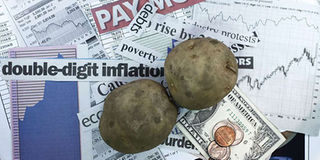Weak economic policies will lead Kenya into stagflation

Standard economic theory holds that policymakers face a trade-off between unemployment and inflation. PHOTO | FILE | NATION MEDIA GROUP
What you need to know:
- Revenue from tax collection is increasingly being directed towards servicing debt while precious little is left for development.
- Money should be withdrawn from white elephant projects and diverted to opening those idle fertile lands by way of investments in roads, water, electricity and security
The Kenyan economy is starting to buckle under the weight of weak economic policies.
The latest estimate of Growth Domestic Product shows that economic growth is slowing down.
Last week alone, three major corporates – Stanbic, EABL and Telkom - announced plans to lay off employees in a trend that will contribute to higher levels of unemployment.
Inflation has steadily been rising in recent months and for the first time in Kenya’s history, the country bought more goods from African countries than it sold to the continent, creating up an unprecedented trade-deficit.
If the existing economic policies do not change, Kenya will find itself in stagflation – a precarious situation that presents a toxic mix of high inflation, high unemployment and low growth.
Standard economic theory holds that policymakers face a trade-off between unemployment and inflation.
PHILLIPS CURVE
When more jobs are created, leading to increased levels of employment, we should expect to see higher rates of wage rises, which should lead to higher inflation.
This is captured in the single equation economic model known as the Phillips Curve.
However, economic history shows that this model is only applicable in the short-run but collapses in the long-run, leading to the situation we are now facing in Kenya where both inflation and unemployment are rising within the context of an economic slowdown.
But how did we get here? It must be said that key economic principles have been largely ignored in recent years.
Monetary policy, which is the handmaid of economic growth, has been weakened since the introduction of the interest rate cap in 2016, and the Central Bank’s ability to control money supply in the economy has been greatly undermined.
This is despite a court ruling that described the rate cap legislation as unconstitutional.
PUBLIC DEBT
As with any price-capping policy, the natural effects of shortages soon started emerging and growth of credit to the private sector declined from highs of about 20 per cent to lows of about five per cent, resulting in an immense strain on businesses while lowering the overall aggregate demand for goods and services in the economy.
The fiscal policy coming from the Treasury has also not inspired confidence. Several years of piling up public debt has taken its toll on the economy.
Revenue from tax collection is increasingly being directed towards servicing debt while precious little is left for development.
Furthermore, the government has embarked on a major fiscal tightening by freezing capital expenditure on new projects and this will greatly slow down economic development across various regions in the country.
INTEREST RATE CAP
As is expected, the combined monetary and fiscal tightening has created a tough operating environment, leaving behind a trail of broken businesses.
The default rate on bank loans has reached its highest point in 12 years, largely driven by reduced access to credit and delayed payment to suppliers. Once vibrant businesses are now operating on a wing and a prayer.
While it is true that the global economy has lost momentum, Kenya’s economic pains are mostly self-inflicted, and the solutions are readily available.
For starters, Parliament must humbly accept to untie the hands of Central Bank by removing the interest rate cap legislation and allow the banking regulator the space to apply the optimal monetary policy.
The desire by MPs to protect citizens from unscrupulous banks that charge high interest rates is quite legitimate, but it needs to be balanced by the view that in open free markets, prices are determined by supply and demand and cannot be legislated.
INTEGRITY
Secondly, the National Treasury needs to dissociate itself from narratives of plunder and mismanagement and adopt a strategy to become a Centre of Excellence in financial management.
An independent debt management unit should be tasked with refinancing Kenya’s debt stock, which should be quite possible now, given that global interest rates are heading south.
On the budgetary side, Treasury should deepen engagement with the private sector and commit to unlocking the country’s factors of production.
Money should be withdrawn from white elephant projects and diverted to opening those idle fertile lands by way of investments in roads, water, electricity and security.
The Judiciary should be adequately resourced to dispense justice efficiently and all government services should be digitised.
Counties will also need to play their role in creating new economic hubs across the country.
SKILLED LABOUR
As it stands right now, consumption is almost entirely skewed to Nairobi and Mombasa, hence the high rate of migration into the capital city.
One of the biggest challenges of devolution has been in attracting a high-quality labour force away from Nairobi to the counties due to the lack of social amenities of comparable standards.
That said, the rapid expansion of universities across the various regions of Kenya will ensure counties have easy access to high quality talent.
All said and done, Kenya is at a crossroads and faces several critical policy options regarding the country’s economy.
The government should carefully weigh each option before deploying the relevant strategies that will lead the country to a prosperous future.
The writer is the Chief Economist at Mentoria Economics; @kgichinga




